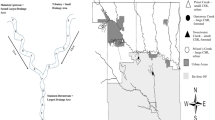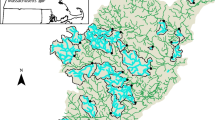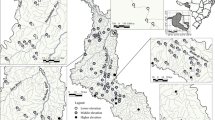Abstract
Channelization and urbanization are anthropogenic alterations that act on the reach- and catchment-scale, respectively, to degrade stream habitats. As urban areas continue to expand in the tropics the number of channelized streams will likely increase as well. We examined in-stream habitat and fish assemblage structure in stream reaches with a range of channel alterations and sub-catchment urban land use in the Río Piedras watershed, Puerto Rico. Nine reaches were surveyed and classified into three categories: unaltered channels (natural), channels that had been straightened and may have reinforced banks (intermediate), or channels where the bank and bottom was replaced with concrete (concrete-channelized). Fishes were sampled using triple-pass electrofishing and relevant reach- and catchment-scale abiotic environmental variables were measured for each site. Fish assemblage structure in the Río Piedras appears to be influenced by both reach- and catchment-scale abiotic environmental factors. Natural and intermediate reaches with moderately high levels of sub-catchment urbanization had relatively high biomass, species-rich, and native-dominated fish assemblages whereas concrete-channelized reaches with very highly urbanized sub-catchments had fish assemblages with few to no native species and highly abundant, tolerant, and exotic species.








Similar content being viewed by others
References
Allouche, S., 2002. Nature and functions of cover for riverine fish. Bulletin Français de la Pêche et de la Pisciculture 365: 297–324.
Aravindan, C., 1980. Food selection and feeding habits of Tilapia mossambica Peters in different ecological habitats. Proceedings of the Indian National Science Academy B46: 54–57.
Arthington, A., 1989. Diet of Gambusia affinis holbrooki, Xiphophorus helleri, X. maculatus and Poecilia reticulata (Pisces: Poeciliidae) in streams of southeastern Queensland, Australia. Asian Fisheries Science 2: 193–212.
Baker, J. A. & S. T. Ross, 1981. Spatial and temporal resource utilization by southeastern cyprinids. Copeia 1: 178–189.
Berra, T. M., 2007. Freshwater Fish Distribution. University of Chicago Press, Chicago.
Brasher, A. M. D., 2003. Impacts of human disturbances on biotic communities in Hawaiian streams. BioScience 53: 1052–1060.
Casatti, L., 2005. Fish assemblage structure in a first order stream, southeastern Brazil: longitudinal distribution, seasonality, and microhabitat diversity. Biota Neotropica 5: 75–83.
Courtenay, W. Jr., & G. Meffe, 1989. Small fishes in strange places: a review of introduced poeciliids. In Meffe, G. K. & F. F. Snelson Jr (eds), Ecology and Evolution of Livebearing Fishes (Poeciliidae). Prentice Hall, Englewood Cliffs, NJ: 319–331.
Death, R. G. & M. K. Joy, 2004. Invertebrate community structure in streams of the Manawatu-Wanganui region, New Zealand: the roles of catchment versus reach scale influences. Freshwater Biology 49: 982–997.
De Jesús-Crespo, R. & A. Ramírez, 2011. Effects of urbanization on stream physicochemistry and macroinvertebrate assemblages in a tropical urban watershed in Puerto Rico. Journal of the North American Benthological Society 30: 739–750.
Debrot, A. O., 2003. A review of the freshwater fishes of Curacao, with comments on those of Aruba and Bonaire. Caribbean Journal of Science 39: 100–108.
Esselman, P. C. & J. D. Allan, 2010. Relative influences of catchment- and reach-scale abiotic factors on freshwater fish communities in rivers of northeastern Mesoamerica. Ecology of Freshwater Fish 19: 439–454.
Fitzsimons, M. J., J. E. Parham & R. T. Nishimoto, 2002. Similarities in behavioral ecology among amphidromous and catadromous fishes on the oceanic islands of Hawai’i and Guam. Environmental Biology of Fishes 65: 123–129.
Frissel, C. A., W. J. Liss, C. E. Warren & M. D. Hurley, 1986. A hierarchical framework for stream habitat classification: viewing streams in a watershed context. Environmental Management 10: 199–214.
Gibson, M., 1954. Upper lethal temperature relations of the guppy, Lebistes reticulatus. Canadian Journal of Zoology 32: 393–407.
Gorman, O. T. & J. R. Karr, 1978. Habitat structure and stream fish communities. Ecology 59: 507–515.
Hein, C. L., A. S. Pike, J. F. Blanco, A. P. Covich, F. N. Scatena, C. P. Hawkins & T. Crowl, 2011. Effects of coupled natural and anthropogenic factors on the community structure of diadromous fish and shrimp species in tropical island streams. Freshwater Biology 56: 1002–1015.
Hernández-Rodríguez, M. & L. F. Bückle-Ramirez, 2010. Preference, tolerance and resistance responses of Poecilia sphenops Valenciennes, 1846 (Pisces: Poeciliidae) to thermal fluctuations. Latin American Journal of Aquatic Research 38: 427–437.
Hoeinghaus, D. J., K. O. Winemiller & J. S. Birnbaum, 2007. Local and regional determinants of stream fish assemblage structure: inferences based on taxonomic vs. functional groups. Journal of Biogeography 34: 324–338.
Holmquist, J. G., J. M. Schmidt-Gegenbach & B. B. Yoshioka, 1998. High dams and marine-freshwater linkages: effects on native and introduced fauna in the Caribbean. Conservation Biology 12: 621–630.
Jhingran, A., 1992. Performance of tilapia in Indian waters and its possible impact on the native ichthyofauna. FAO Fisheries Report 458: 143–161.
Kinzie, R. A., 1988. Habitat utilization by Hawaiian stream fishes with reference to community structure in oceanic island streams. Environmental Biology of Fishes 22: 179–192.
Kwak, T.J., P. B. Cooney & C.H. Brown, 2007. Fishery population and habitat assessment in Puerto Rico streams: phase 1 final report. Federal Aid in Sport Fish Restoration Project F-50 Final Report. Marine Resources Division, Puerto Rico Department of Natural and Environmental Resources, San Juan.
Lammert, M. & J. D. Allan, 1999. Assessing biotic integrity of streams: effects of scale in measuring the influence of land use/cover and habitat structure on fish and macroinvertebrates. Environmental Management 23: 257–270.
Lyons, J., 1996. Patterns in the species composition of fish assemblages among Wisconsin streams. Environmental Biology of Fishes 45: 329–341.
Magurran, A. E., 2009. Threats to freshwater fish. Science 325: 1215.
Maksimovic, C., Z. Todorovic & B. F. Braga Jr, 1993. Urban drainage problems in the humid tropics. Hydrology of Warm Humid Regions 216: 377–401.
March, J. G., J. P. Benstead, C. M. Pringle & F. N. Scatena, 2003. Damming tropical island streams: problems, solutions, and alternatives. BioScience 53: 1069–1078.
Martinuzzi S., W. A. Gould & O. M. Ramos González, 2007. Land development, land use, and urban sprawl in Puerto Rico integrating remote sensing and population census data. Landscape and Urban Planning 79: 288–297.
McCune, B. & M. J. Mefford, 1999. PC-ORD: Multivariate Analysis of Ecological Data; Version 4. MjM Software Design, Glendale, CA.
McDowall, R. M., 2007. On amphidromy, a distinct form of diadromy in aquatic organisms. Fish and Fisheries 8: 1–13.
McMahon, T., A. Zale & D. Orth, 1996. Aquatic habitat measurements. In Murphy, B. R. & D. W. Willis (eds), Fisheries Techniques, 2nd ed. American Fisheries Society, Bethesda, MD: 83–120.
McRae, M. G., 2001. Microhabitat use in an assemblage of native and introduced stream fishes in Wailoa Stream, Island of Hawaii. Thesis. Louisiana State University.
Meffe, G. K. & W. Minckley, 1987. Persistence and stability of fish and invertebrate assemblages in a repeatedly disturbed Sonoran Desert stream. American Midland Naturalist 117: 177–191.
Montgomery, M. R., 2008. The urban transformation of the developing world. Science 319: 761–764.
Morgan, R. & S. Cushman, 2005. Urbanization effects on stream fish assemblages in Maryland, USA. Journal of the North American Benthological Society 24: 643–655.
Neal, J. W., C. G. Lilyestrom & T. J. Kwak, 2009. Factors influencing tropical island freshwater fishes: species, status, and management implications in Puerto Rico. Fisheries 34: 546–554.
Onorato, D., R. A. Angus & K. R. Marion, 2000. Historical changes in the ichthyofaunal assemblages of the upper Cahaba River in Alabama associated with extensive urban development in the watershed. Journal of Freshwater Ecology 15: 47–63.
Osterkamp, W. R., 2001. Earth surface processes, materials use, and urban development: a case study of the San Juan metropolitan area, northeastern Puerto Rico. Water Resources Division, US Geological Survey, Tucson, Arizona.
Paul, M. J. & J. L. Meyer, 2008. Streams in the urban landscape. Annual Review of Ecology and Systematics 32: 333–365.
Philippart, J. C .L. & J. C. Ruwet, 1982. Ecology and distribution of tilapias, 7th ed. In Pullin, R. S. V. & R. H. Lowe-McConnell (eds), ICLARM Conference Proceedings, Manila, Philippines.
Poff, N., J. Allan, M. Bain & J. Karr, 1997. The natural flow regime. BioScience 47: 769–784.
Power, M. E., 1987. Predator avoidance by grazing fishes in temperate and tropical streams: importance of stream depth and prey size. In Kerfoot, W. C. & A. Sih (eds), Predation: Direct and Indirect Impacts on Aquatic Communities. University of New England Press, Hanover, NH: 333–351.
Ramírez, A., R. De Jesús-Crespo, D. Martinó-Cardona, N. Martínez-Rivera & S. Burgos-Caraballo, 2009. Urban streams in Puerto Rico: what can we learn from the tropics? Journal of the North American Benthological Society 28: 1070–1079.
Rodd, F. H. & D. N. Reznick, 1997. Variation in the demography of guppy populations: the importance of predation and life histories. Ecology 78: 405–418.
Schlosser, I. J., 1982. Fish community structure and function along two habitat gradients in a headwater stream. Ecological Monographs 52: 395–414.
Schoenfuss, H. L. & R. W. Blob, 2007. The importance of functional morphology for fishery conservation and management: applications to Hawaiian amphidromous fishes. Bishop Museum Bulletin in Cultural and Environmental Studies 3: 125–141.
Smiley, P. C. J. & E. D. Dibble, 2005. Implications of a hierarchical relationship among channel form, instream habitat, and stream communities for restoration of channelized streams. Hydrobiologia 548: 279–292.
Smith, G. C., A. P. Covich & A. M. D. Brasher, 2003. An ecological perspective on the biodiversity of tropical island streams. BioScience 53: 1048–1051.
Tamada, K., 2011. River bed features affect the riverine distribution of two amphidromous Rhinogobius species. Ecology of Freshwater Fish 20: 23–32.
Vannote, R. L., G. W. Minshall, K. W. Cummins, J. R. Sedell & C. E. Cushing, 1980. The river continuum concept. Canadian Journal of Fisheries and Aquatic Sciences 37: 130–137.
Walsh, C. J., A. H. Roy, J. W. Feminella & P. D. Cottingham, 2005. The urban stream syndrome: current knowledge and the search for a cure. Journal of the North American Benthological Society 24: 706–723.
Wang, L., J. Lyons & P. Kanehl, 2001. Impacts of urbanization on stream habitat and fish across multiple spatial scales. Environmental Management 28: 255–266.
Wesche, T. A., 1985. Stream channel modifications and reclamation structures to enhance fish habitat. In Gore, J. A. (ed.), The Restoration of Rivers and Streams: Theories and Experience. Butterworth Publishers, Boston, MA: 103–164.
Wetzel, R., 2001. Limnology: Lake and Reservoir Ecosystems, 3rd ed. Academic Press, New York.
White, K., J. Gerken, C. Paukert & A. Makinster, 2009. Fish community structure in natural and engineered habitats in the Kansas River. River Research and Applications 26: 797–801.
Wiens, J. A., 2002. Riverine landscapes: taking landscape ecology into the water. Freshwater Biology 47: 501–515.
Acknowledgments
The comments on our study design and methods training provided by Patrick Cooney and Will Smith greatly improved this project. Diana Martinó and Keysa Rosas were extremely helpful during the fieldwork portion of the study. Rebeca De Jesús-Crespo’s digitizations were used for classifying land use. Comments from Matt Whiles, Jorge Ortiz, and Alberto Sabat improved our manuscript. Finally, a preliminary study by Martin Perales provided important information that was used in the design of this study. Support for this research was obtained from the Luquillo Long-Term Ecological Research program, a GK-12 Fellowship and the Institute for Tropical Ecosystem Studies at the University of Puerto Rico.
Author information
Authors and Affiliations
Corresponding author
Additional information
Handling editor: David Dudgeon
Rights and permissions
About this article
Cite this article
Engman, A.C., Ramírez, A. Fish assemblage structure in urban streams of Puerto Rico: the importance of reach- and catchment-scale abiotic factors. Hydrobiologia 693, 141–155 (2012). https://doi.org/10.1007/s10750-012-1100-6
Received:
Revised:
Accepted:
Published:
Issue Date:
DOI: https://doi.org/10.1007/s10750-012-1100-6




